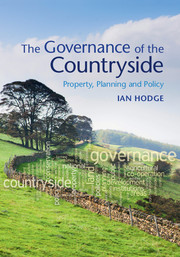Book contents
- Frontmatter
- Contents
- Preface
- Acknowledgements
- List of abbreviations
- Part I Introduction
- Part II Historical models
- Part III Governance under sectoral policies
- 6 Agricultural policies, farming and the environment
- 7 Land, development and planning
- 8 Protected Areas: the example of National Parks
- 9 Wildlife conservation: National Nature Reserves, Sites of Special Scientific Interest and Large-scale Conservation Areas
- 10 Public rights of way and access to the countryside
- 11 The control of agricultural pollution
- 12 The development of agri-environment policy
- Part IV Alternative approaches to governance
- Part V Conclusions
- References
- Index
10 - Public rights of way and access to the countryside
from Part III - Governance under sectoral policies
Published online by Cambridge University Press: 05 February 2016
- Frontmatter
- Contents
- Preface
- Acknowledgements
- List of abbreviations
- Part I Introduction
- Part II Historical models
- Part III Governance under sectoral policies
- 6 Agricultural policies, farming and the environment
- 7 Land, development and planning
- 8 Protected Areas: the example of National Parks
- 9 Wildlife conservation: National Nature Reserves, Sites of Special Scientific Interest and Large-scale Conservation Areas
- 10 Public rights of way and access to the countryside
- 11 The control of agricultural pollution
- 12 The development of agri-environment policy
- Part IV Alternative approaches to governance
- Part V Conclusions
- References
- Index
Summary
The exclusive right to the land for purposes of cultivation does not imply an exclusive right to it for purposes of access; and no such right ought to be recognised, except to the extent necessary to protect the produce against damage, and the owner's privacy against invasion.
John Stuart Mill, 1848, Principles of Political Economy with some of their Applications to Social Philosophy. Book II, Chapter II 29, Longmans, Green and Co., London, www.econlib.org/library/Mill/mlP15.html#Bk.II, Ch.IIA flame had been lit and things could never be quite the same again. Time after time in negotiations they were reminded of the Mass Trespass when they were trying to kill negotiation by procrastination.
Benny Rothwell, leader of the 1932 Mass Trespass on Kinder Scout, pp. 55–56 in The Battle for Kinder Scout, Willow Publishing, Altrincham, 2012As rights of way determined and sustained by use, they constitute a labyrinth of liberty, a slender network of common land that still threads through our aggressively privatized world of barbed wire and gates, CCTV cameras and ‘No Trespassing’ signs.
Robert Macfarlane (2012) The Old Ways: A Journey on Foot, p. 16 Hamish Hamilton, London10.1 Introduction
Urbanisation and enclosure separated much of the population from their traditional access to rural areas, but at the same time, informal outdoor recreation away from concentrated settlements and urban pollution has an increased importance for both physical health and spiritual renewal (Gray, 2010). As noted in Chapter 1, we make vast numbers of visits to the countryside, some 1.4 billion visits in England between August 2011 and July 2012. Walking in the countryside is a regular activity for many. The majority of visits involve walks within a short distance of where we live and hence rely on our being able to get out into the countryside or open space within urban areas that are closest to our homes. At the same time, access to areas of the highest landscape value is important too. We noted the annual number of day visits to the National Parks in Chapter 8; over 23 million to the Lake District and 10 million to the Peak District. Such areas rely substantially on the expenditure associated with recreation and tourism that supports a significant proportion of total economic activity and incomes across rural areas.
- Type
- Chapter
- Information
- The Governance of the CountrysideProperty, Planning and Policy, pp. 199 - 213Publisher: Cambridge University PressPrint publication year: 2016

